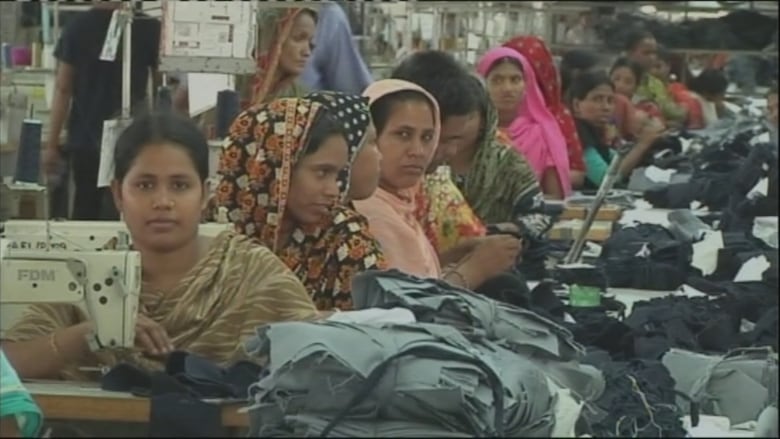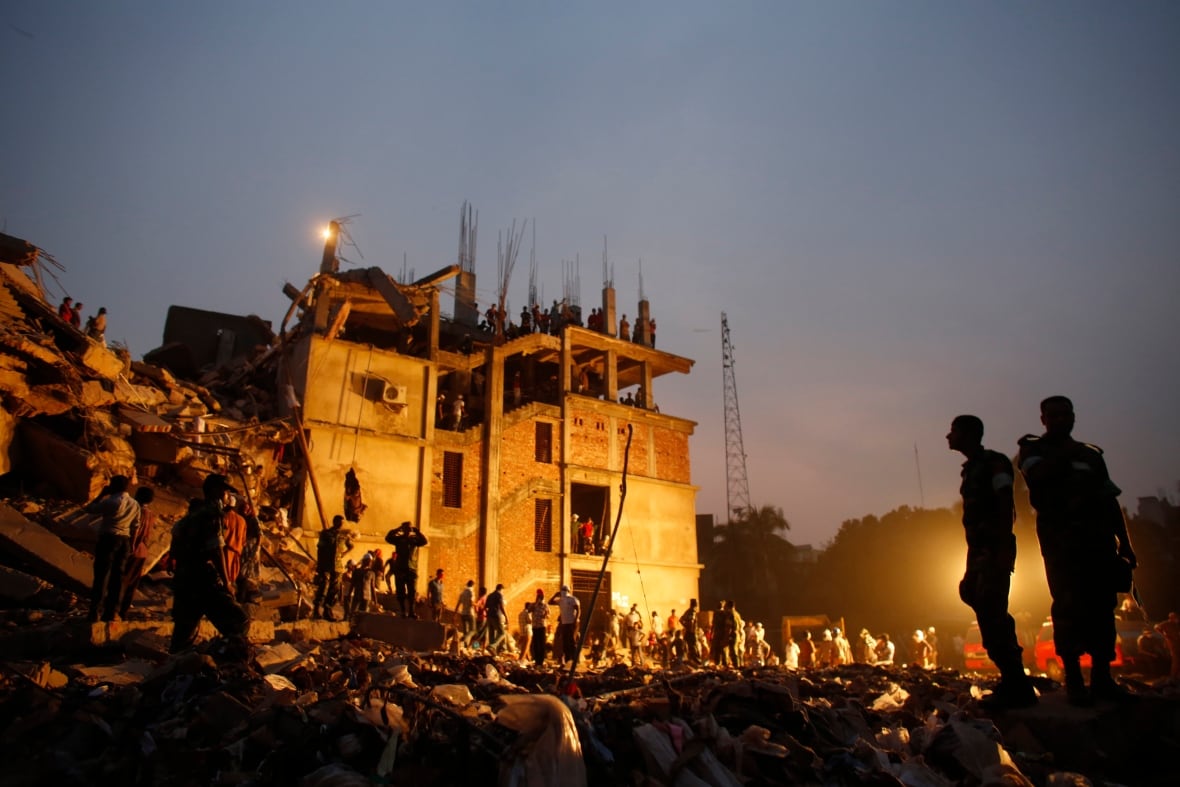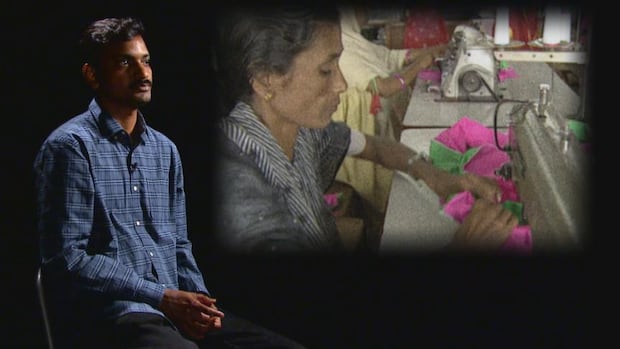I've seen first-hand the true price of fast fashion — people suffering, lives lost
Itrat Anwar: 'As a consumer, I now ask myself, "Who made this and at what cost?"'

This First Person article is the experience of Itrat Anwar, a newcomer from Bangladesh who now calls Steinbach, Man., his home. For more information about CBC's First Person stories, please see this FAQ. You can read more First Person articles here.
The true cost of your $100 piece of clothing isn't one you can see. Sometimes, it's measured in blood. Sometimes, the cost is human lives.
And I saw it first-hand.
I walked through roaring sewing lines, sat in crowded factory canteens and watched workers endure unbearable conditions for wages so low they could barely survive. In their suffering, I realized something crucial — most of us have no idea where our clothes come from or the price others pay for them.
Bangladesh's garment industry is one of the largest in the world. It contributes more than 80 per cent of the country's exports (according to Economics Observatory), employs more than three million people, mostly women, in more than 4,000 factories in the Dhaka and Chittagong divisions, and brings in, on average, $46 billion US annually.
For Bangladesh, this industry is the backbone of the economy. But it comes at a staggering human cost.
After completing my MBA, I joined a company that sold machinery to garment factories. From 2012 onward, I spent three to five days a week visiting factories across Dhaka, Narayanganj, Ashulia, Savar and Gazipur. I worked closely with production managers and machine layout engineers. I had access to both the boardrooms and the boiler rooms — and what I saw there shook me. I visited hundreds of factories, and each day revealed more about the brutal realities behind the clothes we wear.
I could no longer be part of a system I no longer believed in.- Itrat Anwar
I watched thousands of workers pour into factory gates every morning – some walking miles just to earn a wage barely enough to feed their families. Inside, the air was thick with dust, the noise from the machines deafening, and the pressure to meet impossible production quotas relentless. These workers often toiled 14 to 16 hours a day, seven days a week. During peak seasons, they would work until 2 or 3 a.m. just to meet the deadlines set by global fashion brands. Refusing overtime wasn't an option. Many were terrified of losing their jobs if they did. In some cases, overtime wasn't even compensated.
In the most hazardous corners of the factories, I had to pass through dyeing sections where massive machines churned with toxic chemicals, releasing fumes that stung my eyes and burned my throat. Boiler rooms felt like industrial furnaces — metal chambers radiating unbearable heat, with pipes hissing and valves rattling under pressure. The air was thick with steam and chemical vapours, making every breath a struggle. The noise was deafening, the floors often slippery, and overhead wiring dangerously exposed.
What shocked me most was the lack of basic safety: no proper ventilation that I could see, no protective gear, and often, no functional emergency exits. In many buildings, a single blocked stairwell could trap hundreds. For me, enduring this environment for a few hours was unbearable. For the workers, it was their everyday reality, one misstep away from injury or worse.
The Western world often talks about "ethical" fashion. Brands promise safer workplaces, fair wages and dignity for workers. These brands are well-known — their advertisements powerful, their reputations impeccable.
But the reality I witnessed was different. While these companies publicly called for higher standards, it appeared to me that the priorities were cheap labour, fast delivery and massive profit margins. Worker safety and fair pay were often pushed to the bottom of the priority list. In conversations with workers, I learned that some went months without wages, while the companies ignored their plight. A local media outlet back home in Bangladesh reported that some workers went 14 months without pay.
I still remember the horror of the Rana Plaza collapse on Wednesday, April 24, 2013, around 9 a.m. local time. I was on my way to work that morning when I heard the news. (In fact, I could have visited that factory on the very same day. It was part of my regular duty.)

More than 1,100 workers died in that collapse. Many of them were young women, mothers of the very children I had also seen in the factories.
The collapse shocked the world, but for those of us in the industry, it wasn't a surprise. Cracks in the walls, faulty wiring, safety risks that were ignored — all the signs had been there. But production had to continue.
After Rana Plaza, there was global outrage. Brands made high-profile promises to do better. Some factories improved, and some brands stepped up. But to me, it seemed like most simply moved on, shifting production to countries with even cheaper labour, constantly chasing lower costs.
And the workers? They stayed, still earning barely enough to survive, still afraid to speak up, still hoping for change that rarely came.
They deserve more than mere survival. They deserve dignity, safety and a voice.- Itrat Anwar
One day during that period still haunts me. I had my DSLR camera with me (something I often carried to capture interesting scenes). When I arrived at one factory, the gates were shut, and workers were rioting outside over months of unpaid wages.
I waited near a tea stall, hoping to meet the manager. Soon, a few men approached, questioning my presence. When they noticed my camera, their tone shifted and the questions came fast.
"Which media are you from?" one asked.
I replied that I wasn't from the media and was there for a scheduled meeting.
But the tension in the air was palpable and the man asked again, "Are you from a newspaper or TV?"
I realized this wasn't just casual curiosity. They were watching me. They wanted to know what I had photographed. If I had captured images of the strike, I could have been in danger. I quickly hailed a taxi and left, my heart racing. These weren't concerned workers. They were local labour leaders, meant to protect workers, but now part of a system that silences the truth, instead of defending it.
WATCH | Itrat Anwar talks about what he saw in garment factories in Bangladesh:
Eventually, I left the garment industry. I could no longer be part of a system I no longer believed in. I had seen too much: people suffering in silence, lives lost needlessly and promises repeatedly broken.
Yet even now, I can't forget the faces in those factories — the strength of the women at the sewing machines, the young men dragging heavy bundles of fabric, the children waiting patiently outside for their mothers. They deserve more than mere survival. They deserve dignity, safety and a voice.
The next time you buy a T-shirt, a pair of jeans or a dress, check the label. It might say "Made in Bangladesh," "Made in Cambodia" or "Made in Vietnam." Behind each of those labels is a story, maybe one of silent suffering. Some reflect resilience; others, exploitation.
And too often, they speak of lives lost in the shadows of the global fashion industry.
As a consumer, I now ask myself, "Who made this and at what cost?" Because I've seen first-hand that the true price of fast fashion isn't just counted in dollars, but in human lives, in blood and in the silence of those who were never heard.


